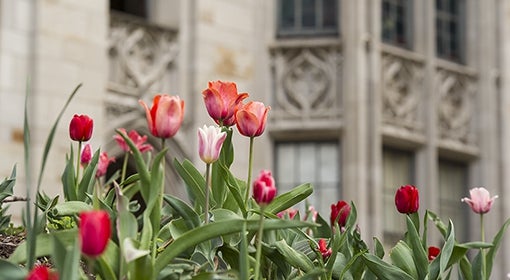From across the Cathedral of Learning lawn, two figures stride past Heinz Memorial Chapel toward Fifth Avenue. Equipped with a clipboard, measuring tape, and a smartphone, they stop beneath the tall trees and move in close.
They scout the sunny ground, picking up a leaf, an acorn. They squint into the treetops, examining bark and low-hanging branches, to aid their analysis. Exactly what kind of tree is this?
After determining the tree’s species, oak, and assessing its health, they stretch their tape long to estimate its diameter—data they’ll use to extrapolate its age.
Then they turn to technology, using phone apps to pinpoint each tree’s location and calculate its height. Carefully they pencil the numbers onto the clipboard log, one tree closer to counting every tree on campus.
The database they’re creating includes an interactive map of each tree’s location—whether on lawns, steep slopes, or even patio planters. They’re documenting rare specimens, invasive species, and sick or dying trees in need of treatment or removal.
For M. Holden, participating with Pitt’s first campus-wide tree inventory is a continuation of “green” activities that began as a child with family hikes through nearby parks. In high school, Holden studied in a summer honors program, learning about acid mine damage on regional streams. At Pitt, the third-year biology major—who is also carrying minors in chemistry, secondary education, and religious studies—has continued on a green path, having served as vice president of the Climate Stewardship Society, a student-sustainability group, and taking on the tree inventory as part of an environmental science class.
The Office of Facilities Management, where Holden is a sustainability intern, connected Holden with T. Eliseuson, a retired geophysicist and a student in Pitt’s Osher Lifelong Learning Institute, which provides non-accredited classes, programs, and educational opportunities designed for adults beginning at age 50. Together, Holden and Eliseuson quickly got to work on the tree inventory.
The project is part of the Pitt Sustainability Plan, released in 2018, which is the framework of goals for initiatives meant, in part, to promote long-term practices across the University that are environmentally responsible, socially equitable, and economically robust. The tree inventory project is just one of many student-led sustainability initiatives, including bringing green roofs, pollinator and rain gardens to campus, and establishing an annual collection of furniture and other items that otherwise might end up as move-out trash.
The tree inventory is a first step in tracking progress toward the goal of increasing the campus tree canopy 50 percent by 2030. The collected data also aids in on-campus biological and environmental science research and will impact Facilities Management’s choices in water management and new landscape designs.
For the short term, Holden and Eliseuson stroll along, expecting to document some 2,500 trees on their first count. Holden says it is more than a walk through nature; it is a chance to help Pitt stay evergreen.
This story appeared in the Spring 2019 edition of Pitt Magazine.





